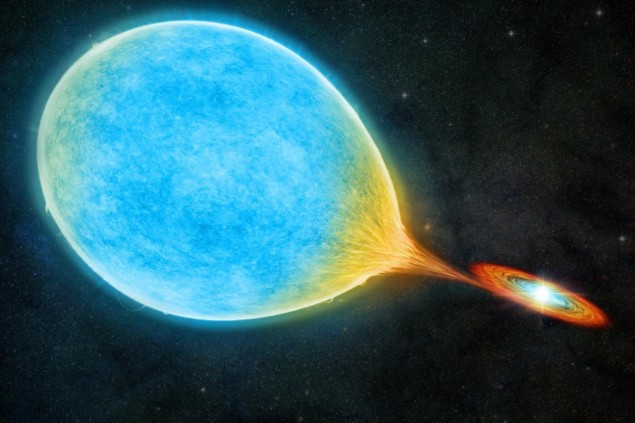
Astronomers have discovered a pair of stars that circle each other in just 51 minutes, which is the most rapid orbit ever seen in such a pairing. The system has been dubbed ZTF J1813+4251 and is an example of a cataclysmic variable – an arrangement consisting of a star in a tight orbit around a dead star called a white dwarf.
As the two stellar objects in a cataclysmic variable lose energy by the emission of gravitational waves, they are drawn closer together and the white dwarf begins to “feed” on the Sun-like “donor” star, ripping material from its surface. ZTF J1813+4251 is located 3000 light-years from Earth and represents the first evidence that cataclysmic variables can shrink enough to have such a short orbital period.
“With the discovery of ZTF J1813+4251, we now know that, in rare circumstances, cataclysmic variables can shrink to an orbital period much shorter than 75 minutes,” team member and researcher at the University of Amsterdam, Jan van Roestel, told Physics World. “There were theoretical predictions that this could happen, but the discovery of ZTF J1813+4251 confirms this without any doubt.”
Van Roestel, along with Kevin Burdge of the Massachusetts Institute of Technology and colleagues also determined other properties of each star – including their masses and radii.
Tiny system
“The binary system consists of a white dwarf and a donor star with a mass of around 0.55 and 0.1 solar masses respectively,” van Roestel says. The distance between them is only 0.4 of the radius of the Sun, which means that the entire binary system could easily fit inside our star. The research also suggests that this tight orbit is the result of the extremely high density of the donor star.
The astronomers found ZTF J1813+4251 in a vast collection of stars observed by the Zwicky Transient Facility (ZTF), which uses a camera attached to a telescope at the Palomar Observatory in California. ZTF has taken more than 1000 high-resolution pictures of wide areas of the sky capturing changes in the brightness of 1 billion stars over periods varying from days to years.
The team used an algorithm to search these data for stars that appeared to flash repeatedly within a period of less than an hour. Such flashes can be caused by two stars in a tight orbit, with one star briefly blocking the light from the other – as is the case for ZTF J1813+4251.
Rare stage of evolution
The observations also revealed that the system is in an interesting stage of its evolution. “We discovered this cataclysmic variable is doing something very special, transitioning from hydrogen accretion to helium accretion,” Burdge explains. “This is happening because the white dwarf started eating an old main sequence star very near the end of its life after that star had built up significant helium in its core.”
Now, the hydrogen atmosphere of the donor star is nearly gone, with the white dwarf stripping the very last remnants of it from its partner. As a result, this donor star will soon be reduced to a helium-rich core, which its white dwarf companion will continue to feast on. The team also predicts that the orbital period of this system will continue to shorten and in around 70 million years it could be as short as 20 minutes.
“The future of this binary star is driven by gravitational waves,” van Roestel says. “The two stars are massive enough and orbit each other close enough that they slowly lose angular momentum through the gravitational waves, which causes their orbital period and separation to decrease further.”
Gravitational wave observations
In principle, these gravitational waves could be detected by astronomers. However, current gravitational-wave observatories are not sensitive enough to do this. In the future, the study of such systems could be done using the planned Laser Interferometer Space Antenna (LISA), which will be more sensitive than existing Earth-based gravitational wave detectors.

Astronomers explain ‘baffling’ James Webb Space Telescope image of binary star
“This discovery is a big deal because there is currently a gravitational wave detector being built, which will be up in space, called LISA, that will see gravitational waves from objects with orbital periods like ZTF J1813+4251,” Burdge says. He adds that this future investigation could fill in a key element missing from our understanding of how stars evolve.
“Cataclysmic variables are really great laboratories for studying accretion physics and binary evolution. Textbooks tend to focus on isolated stars like the Sun. The thing is, that simple story just doesn’t work if you put two stars in a binary next to each other, because they will interact, and that can completely change the outcome.”
“By studying these close interacting binaries, like cataclysmic variables, we are gathering the information needed to finish the textbooks on stellar evolution. Namely, we are starting to understand stellar binary evolution. This system basically answers a key question of how cataclysmic variable binaries form.”
The observation is described in Nature.



